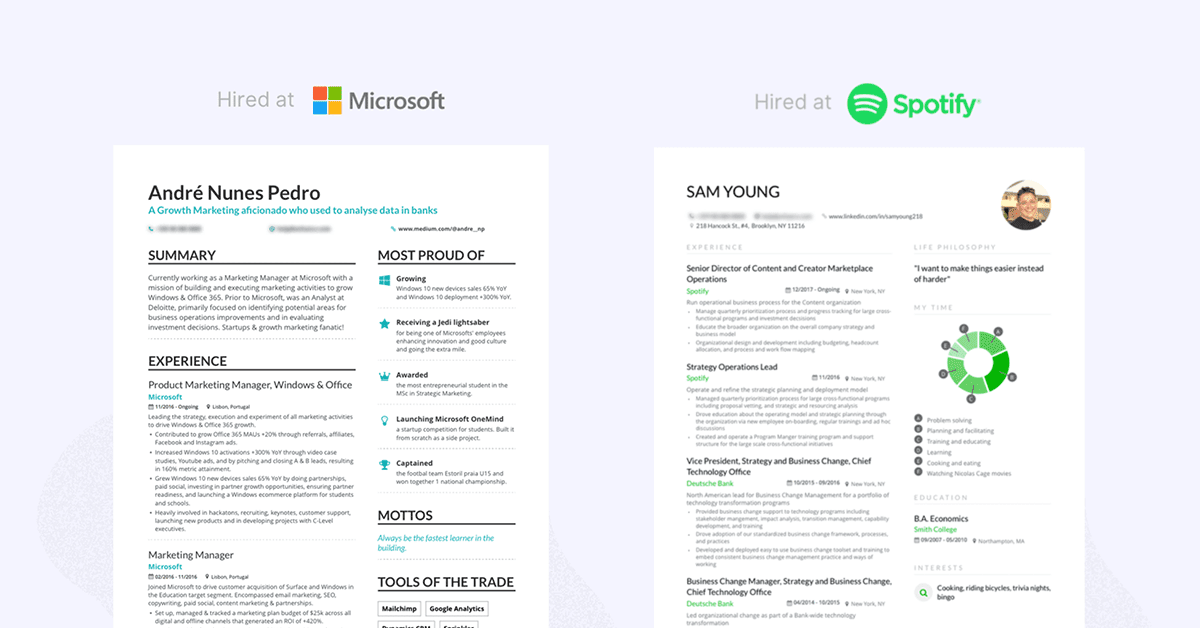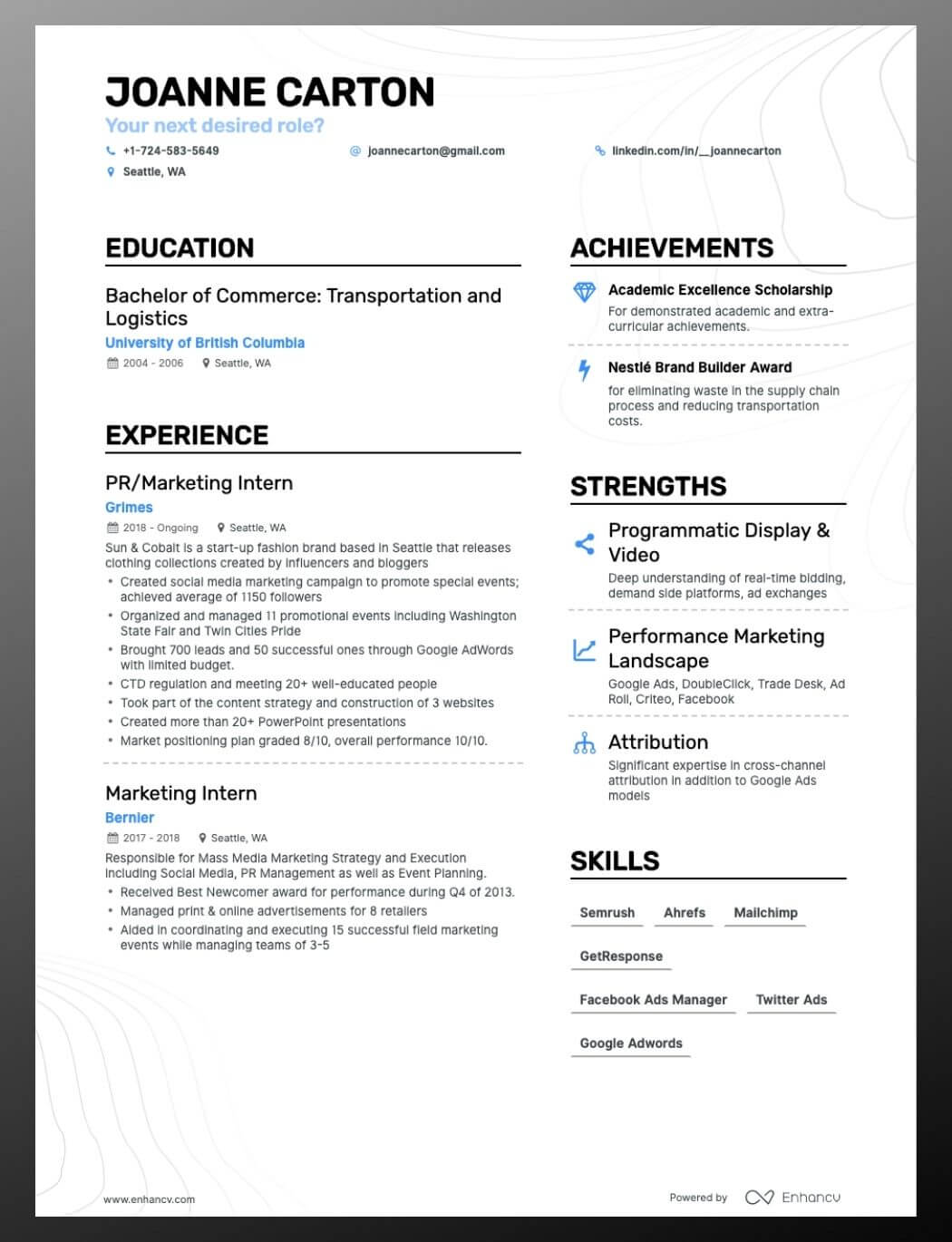Do you know that applying with the wrong type of resume can significantly decrease your chances of getting the job?
No?
You didn’t even know that there are different types of resumes?
Don’t worry. We are here to explain.
In this article you will learn:
- All types of resumes and when to use them
- How to choose the right format for the job you are applying for
- Bonus useful tips and tricks for specific jobs
Save your time with Enhancv’s job-winning resume templates – accustomed for any experience level

What are the different types of resumes that get results today?
First of all, you need to understand the purpose of your resume – telling the story of who you are and what you’ve done.
With that in mind, you can choose the best type of resume to enhance your chances of landing a job interview.
Depending on the position you are applying for there are different types of resumes you can use:
- Chronological Resume
- Functional Resume
- Combination Resume
- Infographic Resume
- Targeted Resume
- Federal Resume
- Business Card Resume
The first 3 can be considered as the main types of resumes, while the rest are so-called secondary.
Read on to learn when to use each type, the correct order of sections, and real examples!
Chronological resume type
If you have many years of experience, a chronological resume is just for you!
But what is a chronological resume and how to create it?
The name itself is self-explanatory.
You start by describing your most recent job first and then moving backward in time for each subsequent role.
There is a list of benefits of this type of resume:
- Provides a clear narrative of your career
- Lines up with expectations
- Big names play in your favor
Check the following example from Jonathan, who got the job at one of the largest grocery retailers in Texas, by using Enhancv’s resume builder to create his chronological resume.

He highlighted his previous experience in data analytics which helped job recruiters estimate his skill level and commitment to the area.
What is the correct structure of the chronological resume?"?
- Header: Here you need to grab the attention of the recruiter. Start with your name and contact information, including your email, phone number, mailing address, and social media contacts.
- Career Overview, Summary, or Objective: Look at this section as a way to consolidate the first impression you’ve already made from your resume header. Prove that you’re the expert they perceive you to be.
- Work experience: Start with your latest position and go backward. List all of your work experience and highlight what you have learned from your previous jobs as well as what you contribute to the applicable position if you obtain it.
- Education: Similarly to the work section, begin with your highest degree and work backward.
- Additional sections: Those are recommended if you lack work experience and you want to supplement the main resume parts. For example, you can add Volunteering, Projects, and References to enhance your chances of landing an interview. Learn more about the additional resume sections here.
Is the chronological resume format right for you?
Let’s be honest.
While this format is great for organizing your experience, it’s arguably an outdated system.
In reality, you better prepare a tailored resume for the position you’re applying for.
We will give you all the information on how to do it properly when we get to the targeted resume type!
Functional resume type
The main focus of the functional resume is on your experience and skills, rather than your work history.
When to use a functional resume?
It’s a preferable format if you have lapses in employment or you are a new graduate who has a limited amount of job experience.
Moreover, those who have had diverse occupations without a focused career path can also benefit from this resume type.
Joanne’s summary is a great example of it.

Skills, Strengths, Achievements, and Volunteering sections’ purpose is to compensate for the lack of work experience.
Joanne used them in the right way.
She highlights her knowledge in digital marketing by showing her strengths in Programmatic Display and Video, Performance marketing display, and Attribution.
Moreover, the listed skills in the marketing area are also highly valuable and can convince the recruiters that she is the right person for the position.
Functional resume structure: order of sections
As we mentioned already, the idea is to emphasize your skills and side projects, not your job history.
- As always, the Header of your resume should stand out.
- Resume objective section can follow since you can outline your biggest strengths and experience, as well as make an offer of how you’re going to provide value to the company.
- You may continue with your education section if your college specialty is highly related to the job you are applying for.
- Add the work experience afterward. In a functional resume, this section is not a priority.
- Use additional sections (Volunteering, Skills, Strengths) as in the example of Joanne’s summary to show to the recruiters that you are the right person for the position.
Chronological and functional are great resume styles.
But it’s even greater if you can combine them!
Combination resume type
This type of resume combines the main elements from a chronological resume and a functional resume. The goal is to highlight both your employment history and skills.
When to use a combination resume?
A hybrid resume creates a solid overall impression and it’s a perfect in-between for hiring managers who are strict on the resume format rules. It is also suitable for those who want to be more flexible in their resumes.
However, it’s not for everyone.
In the best-case scenario, it should be used by those who want to highlight their skills, qualities, and the level of value behind their capabilities.
Take a look at the tech resume template Sam used which helped him get hired and enabled him to switch from investment banking to working for Spotify:

Combination resume structure: order of sections
Building a combination resume can be slightly different from the conventional formats you’re used to.
While this is true, it doesn’t mean there are some big changes when it comes to the layout.
- Start with your resume header.
- Write an Objective or Summary Section where you summarize your entire professional career or make a summary of your skills. Sometimes, you can incorporate both together.
- Employment History. Here you want to start listing out the job titles you’ve held in the past. Do what Sam did in the example above – add a description that outlines your duties, role, responsibilities, and the company success you contributed towards.
- Include your top skills and relevant strengths that directly correlate with the position you are applying for.
- Write about your education. It lets recruiters know you’ve got the academic knowledge that’s required.
- Use Additional Sections to make your resume even more valuable.
Just don’t forget.
The structure may vary, depending on your employment history and strengths and skills.
Check our 6 real examples of combination resumes to get a better idea of how to use it correctly!
Infographic Resume Type
Whereas a traditional resume looks like a wall of text to list information from top-to-bottom, an infographic resume uses layout, color, icons, and font styling to organize content.
When to use an infographic resume?"?
While this resume style can’t replace a standard resume completely, it’s perfect for bringing to interviews, publishing on your site or social media pages, and attaching to email applications.
But wait, I’m not a designer?
You don’t have to be.
With our resume builder, you can easily add and edit a variety of visual elements. That will surely make your summary stand out!
Take a look at the example below:

We bet the “My Time” section was one of the first elements you saw in the resume.
This is not accidental.
Adding infographic pieces to your standard resume can make it easy to navigate and scan.
Furthermore, you can take employers right to the point on your resume where you want them to be.
Infographic resume structure
You won’t find any drastic changes in the format of the infographic resume. You should follow the same structure as in the standard summaries but with visual graphics, elements, and charts.
You can add visual assets to:
- Resume Header
- Education section
- Work experience section
- Additional sections like strengths and skills, my time, passions, languages, etc.
Targeted resume type
A targeted resume is a type of resume specifically prepared for the job that you are applying for. Due to being framed to a specific job position, it has a greater chance of passing both automatic ATS systems and HR manual selection process.
Moreover, this resume style is incredibly effective: when done right, you leave recruiters no other choice but to shortlist you.
When to use a targeted resume?
Long story short:
When you want to significantly improve your chances of getting a dream job.
Some of the benefits of using it are:
- Get shortlisted by recruiters.
- Easily pass automatic ATS systems.
- Become better prepared for an interview.
Still not convinced?
Take a quick look at the example below:

Louis Grenier prepared a unique summary for the requested job. He customized most of the sections of his resume, to make it special.
Targeted resume sections to pay attention to.
- Header: Always customize your headline to make it catchy.
- Work experience section: Identify specific keywords for your area then add them to the resume. Don’t copy workflows. This will make your resume bland and fake. Instead, write them by yourself using this formula – Accomplished [A] as measured in [B] by doing [C].
- Projects section: Add projects that are highly related to your potential future job. Place this section before Education.
- Additional sections: Highlight your achievements that can be associated with the position you want.
Want to learn more about tailoring your resume for the specific position?
Check our detailed guide!
Federal resume type type
A federal type of resume is a comprehensive document used when applying for a position within the Federal government.
Although it still consists of your qualifications, background, and personal details, you must add some unique elements to it.
The structure is similar to traditional resumes with some extra components.
Additional parts to include to a federal resume:
- Resume Header: Here you can add citizenship, highest GS grade, Veterans’ preference, availability, disability, desired locations, and clearance.
- Objective section: Keep it the same as in the traditional resumes.
- Work Experience section: Salary, GS rating, hours worked per week, Supervisor’s name, phone, and whether it’s ok to contact him/her.
- Education section: Keep it the same as in traditional resumes.
- Additional sections: Again same style as for traditional resumes.
Business Card Resume Type
Business cards are still effective, and they can come in handy.
Imagine you’re at a networking event and just met the HR of your dream employer.
A business card resume will help you keep in touch!
The structure and sections are slightly different since you don’t have too much room to work with.
Ideally, you have to share your name, phone number, and contact info.
Think of it as a way to grab the attention of the person you are communicating with. The next step is to send your complete resume, full of valuable information that can eventually land you a job interview!
Some Extra Tips & Tricks When Choosing Your Resume Type
We gave you all the information for available types of resumes. You know why and when to use each style.
Now, we have some extra tips and tricks to help you choose the resume that best suits you and your personality and will offer you the biggest chance of landing your dream job.
- Know Your Audience: Research the culture of the organization you’re courting. That will help you understand which type of resume would be a better fit.
- Review Resume Examples: Do you know that we have more than 530 professional resume examples and samples? There is a pretty good chance to find a template for your desired job and use it!
What type of resume one should have to get an internship?
As a fresh graduate, you will have to prepare a resume that will help you find the right internship.
Everything we said above about traditional types of resumes is applicable here as well.
Choosing the right format is highly individual and depends on your previous work experience, education, side projects, and achievements.
Targeted and functional type sounds like the most convenient in this situation.
For more information along with real examples and templates, you can check our detailed article!
What type of resume format is better for the US vs Europe?"?
Despite many similarities, you can find some differences in resume requirements in the US and Europe:
- Length: An American resume is traditionally a document of one page in length if you lack job experience or two pages if you are a professional with 10+ years of extensive experience. The golden standard for the European version is 2-3 pages.
- Personal information: American standards require only contact information on your resume, while European ask for more personal info like marital status, nationality, age, etc.
- Education: In US resumes, you are expected to put high school information only if you haven’t earned any college degree. Also, if you have an MA in Marketing, you can omit the Bachelor’s or Associate’s degree in the same field. European recruiters expect to see some information on secondary education – at least the name of the school.
- Objective/Summary section: In the US resumes objective is considered obsolete and is appropriate for career changers only. In all other cases, you should use a summary that highlights your professional strengths and competencies. On the other hand, in Europe, it’s acceptable to use both objective and career summary.
OK, in the end, what type of resume is better in the US?
Even though most of the US resumes are created in a reverse chronological format, we think that the targeted resume type is probably the best option.
Its purpose is to present you in the best possible way to recruiters so you can get the position you want to get.
What about Europe?
European resumes also known as CV’s are usually in a reverse-chronological format. Most of the employers prefer seeing summaries in this style so we can consider it as the most suitable at the moment.
What are the best types of resumes for specific jobs?
Have a look at Carole’s resume developed for the accountant job position:

In this case, a chronological resume seems like a good bet. Carole has nearly 10 years of experience in the field of accounting as well as education in the same area.

In this case, Sherry emphasizes her work experiences first and includes a section dedicated to her strengths at the bottom.
Recruiters can see she’s a hard-worker by seeking the results she’s contributed to when describing experiences.
This is a perfect example of a combination type of resume. Check more examples here!
Don’t forget.
Each job you are applying for deserves dedicated time and resume preparation. Know your strengths and highlight them in the best possible way!
Conclusion
Think of the types of resumes as different weapons you can use depending on the “enemy”.
Always research the company to be familiar with its culture, brand mission, and vision. Believe you are the right person to help the organization reach its goals.
Emphasize your employment history when you have it or tailor your resume exactly for the position you want if you lack work experience.
You can always use this guide as a powerful source of information that will help you get hired for your dream job.
Follow our blog for plenty of valuable tips and tricks on how you create your resume into a real piece of art.
***
Did you like this guide? What types of resumes have you used so far? Share it in the comments below.
Make one that's truly you.



